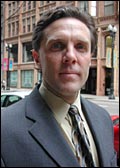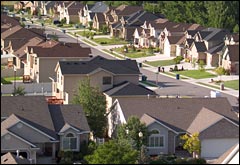Doug Farr was heading into The Grind, a local fair-trade coffee spot in Chicago’s swanky Lincoln Square neighborhood, when he ran into Peter Nicholson, the organizer of the city’s monthly Green Drinks. The two well-heeled unofficial flag-wavers for the local green scene exchanged enthusiastic greetings, and began discussing the latest goings-on.

Doug Farr.
“Ugh. I’m really over green buildings,” Farr said, with a dash of weariness.
Nicholson said nothing, waiting to see if Farr was joking. It was, after all, a strange thing to hear from one of the world’s premier green architects. Farr needed no prompting to continue: “We have to do more. We have to think bigger. We have to start thinking about how we can build whole sustainable communities.”
“That would require systemic change,” Nicholson replied.
“Well, then I guess sustainability is about systemic change.”
It was somewhat of an epiphany, and a maxim that both would later employ. But for Farr, it would also become the panacea for his peculiar architectural malaise.
A New Approach
No one disputes Doug Farr’s place on the pioneering edge of architecture and planning. His firm, Farr Associates, designed two of the 23 buildings on the planet that have received the U.S. Green Building Council‘s LEED Platinum designation — the highest available — and is the only firm with more than one Platinum building to its name. He was recently featured in design: e2, a Brad Pitt-narrated PBS series on the green-building revolution, and his firm — whose mission is to design “sustainable human environments” at the urban neighborhood level — is nearing completion of Sustainable Urbanism: Urban Design With Nature, a cutting-edge book that proposes leadership standards for governments and lawmakers.
Meanwhile, Farr is helping to shepherd the creation of a different set of standards, an outgrowth of USGBC’s voluntary, consensus-based LEED rating system that’s known as LEED for Neighborhood Development, or LEED-ND. The Council, whose LEED steering committee Farr sits on, decided in 2003 to expand its efforts into urban planning and neighborhood development. The intention, quite simply, was to design America’s first green neighborhoods.
With an all-star team including the Congress for the New Urbanism (whose Environmental Task Force Farr also co-chairs) and the Natural Resources Defense Council, the group sought input from Chicago’s pioneering Center for Neighborhood Technology and leaders of the smart-growth movement. Together, these experts tackled questions of architecture and design, planning, development, promotion, and the environmental requirements for site guidelines. They even commissioned a study from the U.S. Centers for Disease Control and Prevention, one of the first reports that would not only summarize the impact of the built environment on public health, but also discuss how this information can be used to redesign how we live, work, and get about.
Unlike the original LEED program, which rates only single buildings and for which site selection is an afterthought, LEED-ND “will place the emphasis on the elements that bring the buildings together into a neighborhood, and relate the neighborhood to its larger region and landscape,” says the council.

McNeighborhoods: this is not sustainable.
Photo: iStockphoto
In short, LEED-ND seeks to revolutionize the way we look at our living space. It envisions compact, walkable neighborhoods with a diversity of green housing stock and commercial buildings, connected to ample park space, no more than a 10-minute walk from any amenity or mass transit stop. Row upon row of green roofs and solar panels renewing heat, water, and energy, and community recycling stations spread throughout. No parking lots, no McMansions, no big-box retailers, no gated communities. Just living with each other, in harmony with the environment, with a true sense of time and place. And the good news is, aside from the various roof adornments, it wouldn’t look that much different from life as it has been lived in America to this point.
It’s a shift that Farr says is long overdue. “There is so much effort that goes into designing and building this one small thing, this single green building,” he says. “The same amount of effort goes into planning two square miles of regular neighborhood, and that will serve us for the next 200 years. [The focus on individual buildings] just doesn’t make any sense.”
Come One, Come All
Of course, coming up with LEED-ND was the easy part. The hard part is selling it to anyone outside the somewhat erudite choir of designers, planners, activists, and policy wonks who make up the sustainable-development movement. This stuff isn’t exactly Snakes on a Plane.
“Most people will not give up conveniences and amenities as long as their income allows them to [afford conveniences and amenities],” Farr says. “It’s just the dominant way of life. It’s a value our society reinforces. There is no measure of shame or guilt that will stop people from unsustainable practices, only price will. If their energy or water costs suddenly skyrocketed, then they’d know what green building was.”
Since homeowners and developers are under no particular obligation to build green, and most cities and states have not taken any regulatory initiative, the burden lies upon the shoulders of the partnering organizations to make LEED-ND the logical and more attractive option to traditional development. The key word there is “option,” since the public, particularly the American consumer, is unlikely to go along with something foisted upon it. Farr believes LEED-ND will become the preferred option when it has proved to save money and retain value, not because of concern for the environment or attachment to a fad.
And the process is moving forward. The rising tide of Katrina/Inconvenient Truth-inspired green awareness and marketing has propelled the LEED-ND idea out of meeting rooms and listservs and across the nation in search of willing participants for the experiment of the decade.
The first stab at a coherent set of guidelines was completed in September 2005. After taking public comments on the draft, the organizers are beginning to work toward version 2.0. As a first step, they’re planning a pilot program in which 40 to 120 neighborhoods across the nation will transform anywhere from two buildings to their whole community. By January, LEED-ND will begin taking applications from retailers who want to be part of the great green experiment by opening or relocating their businesses in a pilot neighborhood. A few high-profile developers and politicians, including Chicago Mayor Richard M. Daley (D), have signed on to promote it. And after the pilot stage, a second public comment period will begin.
This second round of comments will allow the coalition to work directly with the neighborhoods to fine-tune the guidelines and get them ready for mass consumption. By late 2008, LEED-ND version 2.0 will be voted on by the council’s member organizations. By 2009, the LEED-ND Core Committee hopes to release the final version of the guidelines with a media launch, a series of educational programs, and marketing and outreach aimed at both developers and consumers.
But the dripping caveat to all this unbridled optimism is that without a mandate or regulation, it’s still a total crapshoot as to whether LEED-ND will ever take hold.
A Trip to the Farrside
The office of Farr Associates is no next-generation green-building prototype — it’s located in the historic 114-year-old Monadnock Building, Chicago’s tallest all-brick skyscraper. But inside, green spores of sustainability burst forth. The open studio spaces have walls that have been painted by a local artist who used milk-based, non-toxic paints. The desktops are made of natural linoleum, and a translucent divider embedded with leaves separates one desk from another. “Occupancy sensors” trigger energy-conserving lights in the kitchenette, conference room, and main studio. Large, operable First Chicago School windows gaze over nearby Printer’s Row, letting in eastern and southern light that is welcomed by the many living creatures in the space.
More important, the office is also a nexus of cerebral eruptions, a rip in time through which Farr’s staff — 18 brilliant, eccentric, committed souls — have forced their heads to steal a glimpse at the future. The space is the most pure and organic form of think-tank there is, where conversations travel from room to room, in and out of the office, online and offline, taking anywhere from the span of two meals to two weeks.
This is why walking into a Farr Associates happy hour on a Friday afternoon in mid-August took preparation and a dash of improvisation. The mingler/brain-tingler for the staff and their partners in crime over at the Congress for the New Urbanism — whose offices are just across Federal Plaza — was a partial celebration for a successful inaugural presentation and panel discussion on LEED-ND held at the Chicago Metropolitan Planning Council’s office the week before.
Those assembled make fast work of the organic microbrews, wine, and high-grade snacking miscellany. Farr is discussing with two others the method by which speed limits are calculated, and what speeds roads and traffic signals are actually engineered for. He jumps back and forth between his seat and the chalkboard, sketching out small equations and flow charts. Occasionally, he stops to consult with his tireless marketing director, who is wrapping up a grant proposal for a neighborhood-focused public-health project that would look at the effects of sprawl, commuting, and other unhealthy aspects of current urban lifestyles.
In the corner, one of the firm’s architects talks to a visiting consultant from Atlanta and to a young Farr Associates designer from the Twin Cities. They are three brainiacs in varying shades of blonde, clustered together like an American Apparel ad. They busily compare notes on art, science, and how many miles a week they drive.
While Farr’s rival Bill McDonough is ass-deep in China’s industrial revolution, Farr has largely stayed behind to fight the war at home with these energetic troops. It suits his more affable, less ostentatious manner. Preternaturally, he understands his firm as he would one of his designs — each person an essential and integral support beam to the overall success of the structure.
Looking around the conference room, listening to the laughter, factoids, and badinage, one can’t help but feel a sense of calm. These people are actually trying to save the world. And if anyone can, they can — one neighborhood at a time.

